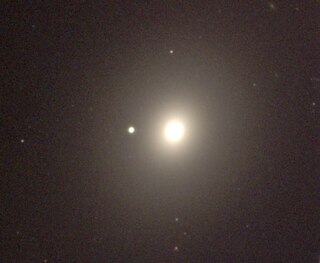
Messier 49 is a giant elliptical galaxy about 56 million light-years away in the equatorial constellation of Virgo. This galaxy was discovered by astronomer Charles Messier in 1777.
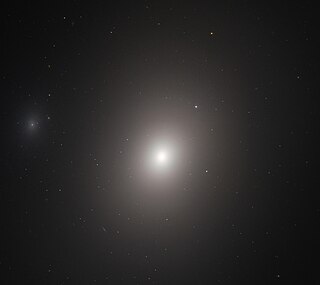
Messier 86 is an elliptical or lenticular galaxy in the constellation Virgo. It was discovered by Charles Messier in 1781. M86 lies in the heart of the Virgo Cluster of galaxies and forms a most conspicuous group with another large galaxy known as Messier 84. It displays the highest blue shift of all Messier objects, as it is, net of its other vectors of travel, approaching the Milky Way at 244 km/s. This is due to both galaxies falling roughly towards the center of the Virgo cluster from opposing ends.

Messier 90 is an intermediate spiral galaxy exhibiting a weak inner ring structure about 60 million light-years away[a] in the constellation Virgo. It was discovered by Charles Messier in 1781.

NGC 4309 is a lenticular galaxy located about 55 million light-years away in the constellation Virgo. The galaxy was discovered by astronomer Christian Peters in 1881 and is a member of the Virgo Cluster.

NGC 4473 is an elliptical galaxy located about 50 million light-years away in the constellation of Coma Berenices. It was discovered by astronomer William Herschel on April 8, 1784. NGC 4473 has an inclination of about 71°. NGC 4473 is a member of a chain of galaxies called Markarian's Chain which is part of the larger Virgo Cluster of galaxies.
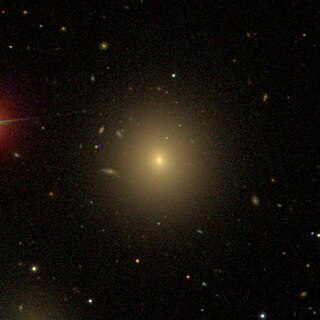
NGC 4458 is an elliptical galaxy located about 54 million light-years away in the constellation of Virgo. It was discovered by astronomer William Herschel on April 12, 1784. NGC 4458 is a member of Markarian's Chain which is part of the Virgo Cluster. It is in a pair with the galaxy NGC 4461. NGC 4458 and NGC 4461 are interacting with each other.
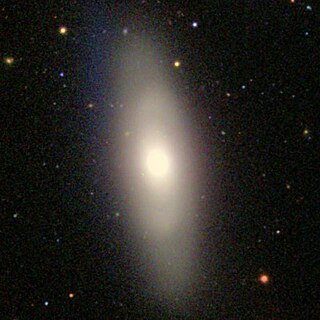
NGC 4461 is a lenticular galaxy located about 50 million light-years away in the constellation of Virgo. It was discovered by astronomer William Herschel on April 12, 1784. NGC 4461 is a member of Markarian's Chain which is part of the Virgo Cluster.

NGC 4468 is a dwarf elliptical galaxy located about 55 million light-years away in the constellation of Coma Berenices. The galaxy was discovered by astronomer William Herschel on January 14, 1787. It is a member of the Virgo Cluster.

NGC 4689 is a spiral galaxy located about 54 million light-years away in the constellation of Coma Berenices. NGC 4689 is also classified as a LINER galaxy. NGC 4689 is inclined at an angle of about 36° which means that the galaxy is seen almost face-on to the Earth's line of sight. NGC 4689 was discovered by astronomer William Herschel on April 12, 1784. The galaxy is a member of the Virgo Cluster.
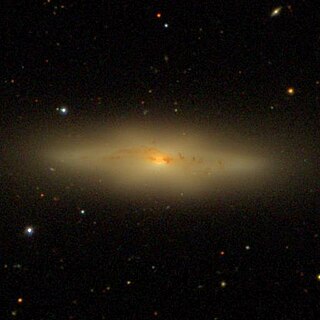
NGC 4469 is a nearly edge-on spiral galaxy located about 55 million light-years away in the constellation of Virgo. It is also classified as a LINER galaxy. NGC 4469 was discovered by astronomer William Herschel on April 15, 1784. It is a member of the Virgo Cluster.
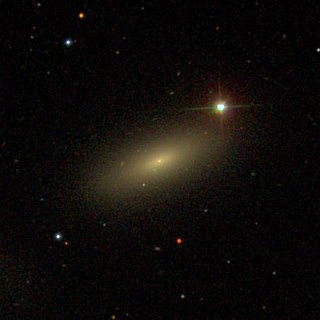
NGC 4436 is a lenticular or dwarf elliptical galaxy located about 60 million light-years away in the constellation of Virgo. NGC 4436 was discovered by astronomer William Herschel on April 17, 1784. The galaxy is a member of the Virgo Cluster.

NGC 4476 is a lenticular galaxy located about 55 million light-years away in the constellation Virgo. NGC 4476 was discovered by astronomer William Herschel on April 12, 1784. The galaxy is a member of the Virgo Cluster.

NGC 4522 is an edge-on spiral galaxy located about 60 million light-years away within the Virgo Cluster in the constellation Virgo. NGC 4522 is losing its molecular gas though ram-pressure stripping as it plows though the cluster at a speed of more than 10 million kilometres per hour. The galaxy was discovered by astronomer John Herschel on January 18, 1828.

NGC 4564 is an elliptical galaxy located about 57 million light-years away in the constellation Virgo. NGC 4564 was discovered by astronomer William Herschel on March 15, 1784. The galaxy is also a member of the Virgo Cluster.

NGC 4580 is an unbarred spiral galaxy located about 70 million light-years away in the constellation Virgo. NGC 4580 is also classified as a LINER galaxy. It was discovered by astronomer William Herschel on February 2, 1786 and is a member of the Virgo Cluster.

NGC 4596 is a barred lenticular galaxy located about 55 million light-years away in the constellation Virgo. NGC 4596 was discovered by astronomer William Herschel on March 15, 1784. NGC 4596 is a member of the Virgo Cluster and has an inclination of about 38°.

ESO 444-46 is a class E4 supergiant elliptical galaxy; the dominant and brightest member of the Abell 3558 galaxy cluster around 195 megaparsecs away in the constellation Centaurus. It lies within the core of the massive Shapley Supercluster, one of the closest neighboring superclusters. It is one of the largest galaxies in the local universe, and possibly contains one of the most massive black holes known. The black hole's mass is very uncertain, with estimates ranging from as low as 501 million M☉, to as high as 77.6 billion M☉.
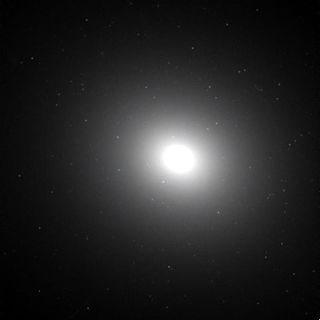
NGC 3309 is a giant elliptical galaxy located about 200 million light-years away in the constellation Hydra. NGC 3309 was discovered by astronomer John Herschel on March 24, 1835. The galaxy forms a pair with NGC 3311 which lies about 72,000 ly (22 kpc) away. Both galaxies dominate the center of the Hydra Cluster.

NGC 3311 is a super-giant elliptical galaxy located about 190 million light-years away in the constellation Hydra. The galaxy was discovered by astronomer John Herschel on March 30, 1835. NGC 3311 is the brightest member of the Hydra Cluster and forms a pair with NGC 3309 which along with NGC 3311, dominate the central region of the Hydra Cluster.

NGC 4318 is a small lenticular galaxy located about 72 million light-years away in the constellation Virgo. It was discovered by astronomer John Herschel on January 18, 1828. NGC 4318 is a member of the Virgo W′ group, a group of galaxies in the background of the Virgo Cluster that is centered on the giant elliptical galaxy NGC 4365.



















